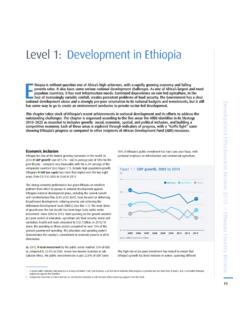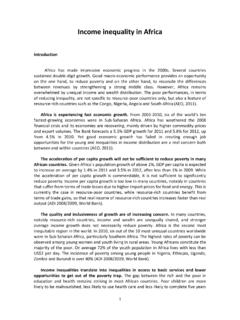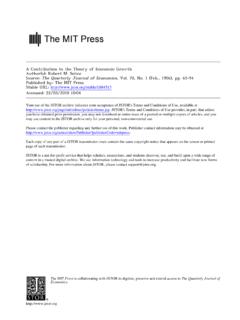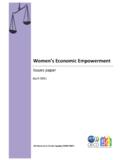Transcription of Migration in Ethiopia - Maastricht Graduate School of ...
1 Migration in Ethiopia : History, Current Trends and Future Prospects Paper Series: Migration and Development Country Profiles Sonja Fransen Katie Kuschminder December 2009 Maastricht Graduate School of Governance 2 Content 1. INTRODUCTION .. 4 2. GENERAL COUNTRY PROFILE OF Ethiopia .. 5 POPULATION AND economic SITUATION .. 5 POLITICAL SITUATION .. 5 ENVIRONMENT, NATURAL DISASTERS, AND FOOD SECURITY .. 6 CULTURE AND ETHNICITY .. 7 STATUS OF WOMEN .. 7 3. HISTORIC OVERVIEW OF Migration IN Ethiopia .. 9 Migration PATTERNS IN THE HORN OF AFRICA .. 9 INTERNATIONAL Migration FROM Ethiopia AND ITS ROOT CAUSES .. 10 Conflict and political violence .. 11 Ecological degradation, famine, and poverty .. 11 12 Rural-urban Migration .. 13 Resettlement.
2 14 4. CURRENT Migration PATTERNS .. 15 INTERNAL Migration .. 15 Rural-urban Migration .. 15 Rural-rural .. 16 Resettlement .. 16 National trafficking .. 17 INTERNATIONAL Migration FLOWS .. 17 International refugees .. 18 International trafficking .. 18 5. THE DIASPORA .. 20 SIZES OF ETHIOPIAN DIASPORA AROUND THE WORLD .. 20 DIVISIONS WITHIN THE DIASPORA .. 21 INVOLVEMENT OF THE DIASPORA .. 22 6. Migration AND DEVELOPMENT .. 23 SKILLED EMIGRATION FROM Ethiopia .. 23 REMITTANCES TO Ethiopia .. 23 DEVELOPMENT IMPACT OF REMITTANCES IN 25 7. POLICIES AND PROGRAMMES REGARDING ETHIOPIAN Migration .. 26 ETHIOPIAN EXPATRIATE AFFAIRS .. 26 AFRICAN 27 INTERNATIONAL ORGANIZATION FOR Migration MISSION IN Ethiopia .. 27 8. Migration RELATIONSHIP WITH THE NETHERLANDS.
3 29 IMMIGRATION OF ETHIOPIANS INTO THE NETHERLANDS .. 29 CHARACTERISTICS OF ETHIOPIAN IMMIGRANTS IN THE NETHERLANDS .. 30 EMIGRATION OF ETHIOPIANS FROM THE NETHERLANDS .. 30 ETHIOPIAN DIASPORA ORGANIZATIONS IN THE NETHERLANDS .. 31 POLICY RELATIONSHIPS BETWEEN Ethiopia AND THE NETHERLANDS AND THE EU .. 31 THE ROLE OF THE IOM IN THE 32 9. FUTURE PERSPECTIVES ON ETHIOPIAN Migration : TRENDS & CHALLENGES 33 10. CONCLUSION .. 35 3 List of Tables & Figures TABLE 1: REFUGEES IN AFRICA AND THE HORN OF AFRICA: 1974-1995 .. 10 TABLE 2: REFUGEES IN THE HORN OF AFRICA AND Ethiopia : 1972-1992 .. 11 TABLE 3: HOST COUNTRIES OF ETHIOPIAN REFUGEES: JANUARY 2009 .. 18 TABLE 4: NUMBER OF PEOPLE UNDER UNHCR CONCERN IN Ethiopia : JANUARY 18 TABLE 5: ETHIOPIAN/ERITREAN IMMIGRANTS AND IMMIGRATION MOTIVES: 29 TABLE 6: ETHIOPIANS IN THE NETHERLANDS BY AGE AND GENDER: 1996, 2003, 2009.
4 30 TABLE 7: ETHIOPIAN EMIGRANTS FROM THE NETHERLANDS BY AGE GROUP: 31 FIGURE 1: MAP OF THE ETHICALLY-BASED REGIONAL STATES OF Ethiopia .. 6 FIGURE 2: PROPORTION OF Ethiopia 'S INTERNATIONAL Migration STOCKS RESIDING IN THE FOLLOWING CONTINENT: 17 FIGURE 3: ESTIMATES OF THE SIZE OF THE ETHIOPIAN DIASPORA IN OECD COUNTRIES .. 20 FIGURE 5: PERCENTAGE OF REMITTANCE FLOWS BY CONTINENT .. 25 4 1. Introduction
5
6 It is estimated that in 2010, percent of global migrants will hail from Africa (UNDP, 2009). Only three percent of the world migrates, and around percent of Africa s population engages in international Migration (UNDP, 2009). This is not surprising, however, as it is well documented in Migration studies that the poorest of the poor do not migrate, and Sub-Saharan Africa is the poorest region in the world.
7 Migration flows from Sub-Saharan Africa are thus occurring within a context of extreme poverty, conflict, and the HIV/AIDs pandemic, all of which impact Migration dynamics (Adepoju, 2008). Ethiopia is one of the poorest countries in the world and in 2005 had an emigration rate of percent, which is low in comparison to Africa as a whole. Ethiopia faces complex challenges of food insecurity, overpopulation, drought, political instability, and ethnic conflict. In addition to these issues, Ethiopia faces large challenges with respect to Migration flows. From the 1980s onward, the Horn of Africa, which consists of Eritrea, Sudan, Djibouti, Somalia, and Ethiopia , became the largest refugee-producing area in the world, with Ethiopia being the largest contributor to the refugee flows (Bariagaber, 1999).
8 As a consequence, Ethiopia became internationally known for its refugee crisis, including problems of managing refugee flows and the issue of repatriation. Today the number of Ethiopians seeking refuge in other countries has drastically decreased. Political instability in the 1970s and the large refugee flows of the 1980s led to the development of the Ethiopian Diaspora, which today is actively engaged in political and development processes in Ethiopia . The Ethiopian Diaspora is one of the largest of all African countries and is concentrated primarily in the United States and United Kingdom. Remittances to Ethiopia from the Diaspora provide an integral source of income for families to sustain themselves through external shocks and meet their basic needs.
9 Internal Migration flows in Ethiopia are currently larger than external flows, but the exact number of people who migrate internally is not known. Internal Migration occurs in the form of rural-urban Migration , rural-rural Migration , and resettlement policies, which are all substantial in Ethiopia . Internal Migration in Ethiopia has traditionally occurred at marriage when the wife moves to live in the husband s community. In addition to this traditional internal mobility, urbanization in Ethiopia is a growing trend that puts pressure on urban infrastructure and resources (De Waal, 1991: Ezra & Kiros, 2001). The objective of this paper is to provide an overview of Migration and development in Ethiopia . This will be achieved through a discussion of historical and contemporary Migration patters (Section 3 and 4), the Ethiopian Diaspora (Section 5), the development impacts of Migration in Ethiopia (Section 6), Migration policies in Ethiopia (Section 7), an exploration of the Migration relationship between the Netherlands and Ethiopia (Section 8), and a conclusion that examines potential future Migration flows in Ethiopia (Section 9).
10 5 2. General Country Profile of Ethiopia Ethiopia is a poor country that has struggled with drought, famines, overpopulation, poverty, and political instability. Ethiopia is a part of the cradle of civilization and is one of the few countries to never be colonized. This has not, however, prevented the country from suffering ethnic conflict and political instability. Today Ethiopia is officially a democratic country, although in practice this would be disputed. The volatile politics and ethnic conflict have contributed to poor governance which, combined with overpopulation and drought, have led to devastating impacts for Ethiopians during the country s famines, resettlement programmes, and political repression. This section will provide a general overview of the current situation in Ethiopia by looking at the current population and economic situation; the political situation; environment, natural disasters, and food security; culture, and; the status of women.





